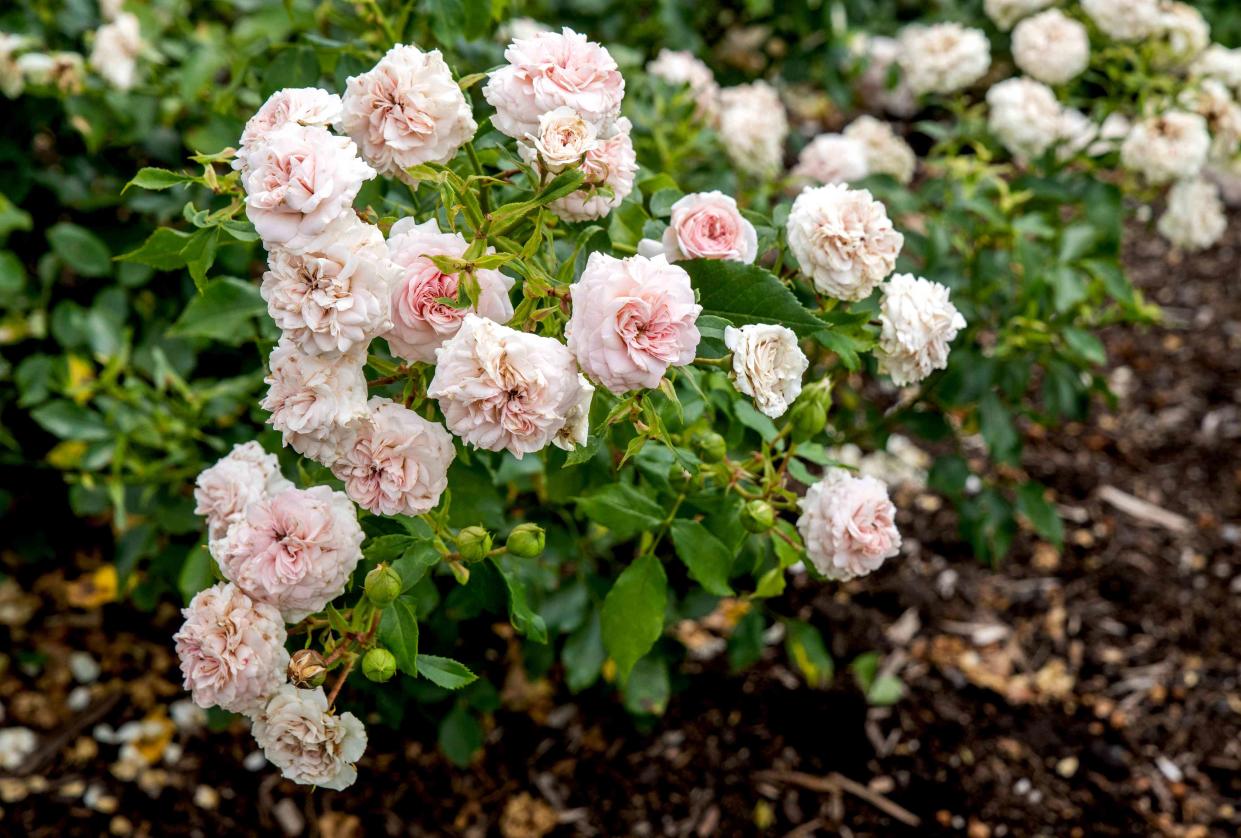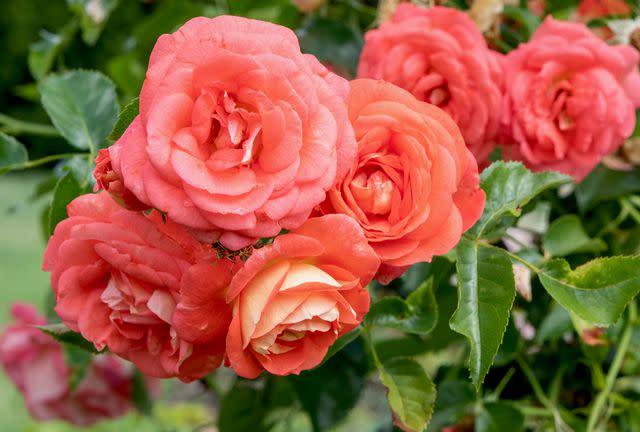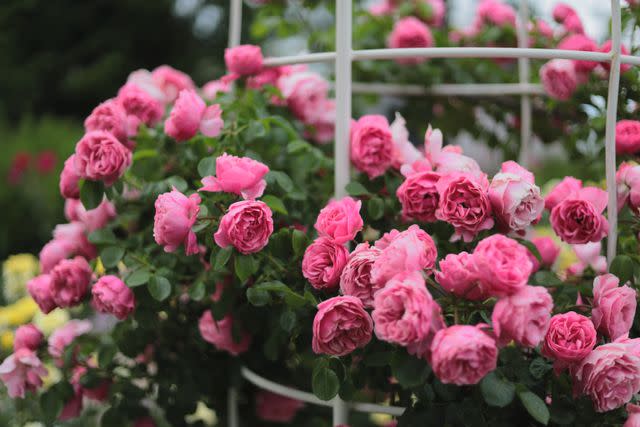How to Grow and Care for Floribunda Roses

The Spruce / Adrienne Legault
Reviewed by Debra LaGattuta
Floribunda roses are a hybrid cross between polyantha species roses and hybrid tea roses, beloved for their robust blooms, hardiness, and long bloom season. Many popular varieties of floribunda roses are grown in the United States and throughout the world. In general, floribunda roses stand taller than polyanthas and are more compact and bushy than hybrid tea roses. Ideal for growing in large garden beds as well as hedges and borders, they tend to top out at heights of five to six feet.
For the best growing results, plant floribunda roses during their dormant season, from early fall to early spring. Plant in a location with full sun; overcrowding them with too many other plants can create too much shade or competition for space. Floribunda roses will grow best when planted in rich, well-draining soil, whether directly in the ground or in large containers.
Common Name | Floribunda rose |
Hybrid | polyantha rose x hybrid teas |
Plant Type | Perennial |
Mature Size | 2–6 ft. tall, 2-6 ft. wide |
Sun Exposure | Full |
Soil Type | Well-drained, with compost |
Soil pH | Acidic, 6-6.5 |
Bloom Time | Summer through first frost |
Flower Color | White, pink, red, crimson, purple, yellow |
Hardiness Zones | 5-9 |
Native Areas | Grown in nurseries |
Toxicity | Non-toxic to humans and pets |
How to Plant Floribunda Roses
When planting floribunda rose varieties, double-digging your garden bed to aerate the soil can ensure the ideal soil environment for it. If planting more than one, space floribunda rose plants 24" to 30" apart for proper spacing
Starting with a plant that was grown in a nursery container, dig a hole twice as wide and equally as deep as the depth of the container.
Carefully remove the rose from its nursery pot, gently spread out its roots, and place in the hole, leaving the graft (the bulge right under the greener top growth) at the level of the soil surface
Backfill the hole with soil and press down lightly to secure the plant in place. .
If you're planting bare root roses instead of nursery pot-grown roses, plant them in late winter to early spring when the soil can be worked and is not frozen. The process to plant a bare root rose differs slightly because you first have to soak the bare roots in a bucket of water to re-hydrate them. Then, dig a hole that is wide and deep enough for the root system, and plant and backfill the hole with soil using a similar method to the pot-grown roses.
Where to Plant
Plant floribunda roses in areas that receive full sun (six to eight hours per day at a minimum) with protection from the wind. Don't overcrowd them with other plants. Do not plant them in shady locations.
When to Plant
For plants in nursery pots, any time of year is acceptable, but the best time to plant is between early fall and early spring. For bare root roses, plant between midwinter and spring if the ground is thawed and not waterlogged.
Care
Floribunda roses are fairly low-maintenance plants if their essential care requirements are met.
Plant in rich and well-draining soil.
Plant in a location that receives more than six hours of sunlight daily.
Water regularly. Floribunda roses can survive periods of drought, but will likely produce fewer blooms with less water.

The Spruce / Adrienne Legault

The Spruce / Adrienne Legault

The Spruce / Adrienne Legault
Light
Floribunda roses require full sun and will struggle to thrive in shady areas.
Soil
Well-draining soil is essential for floribunda roses. For the best success, amend the soil with compost or other organic matter to make a richer blend. Avoid soggy soil. Keep the area around the plant free of weeds, and add a layer of mulch to the surface, to keep the soil moist but not wet.
Water
Roses do well with regular watering, approximately one to two inches weekly, if rain does not provide sufficient moisture. Avoid watering directly onto the leaves as this can encourage fungal infections. Aim water directly on the soil where the roots can absorb it, stopping before it becomes waterlogged or soggy.
Temperature and Humidity
Normal humidity is fine for floribunda roses, though they will thrive most in humid conditions. They can withstand temperatures between 10 degrees Fahrenheit and 100 degrees Fahrenheit, though if temperatures fall to 10 degrees for extended periods they may need additional protection from the cold.
Fertilizing
Floribunda roses thrive most with regular fertilization. During the growing season (approximately four months) fertilize once per month with a nitrogen-prominent mix.

Masako Ishida / Getty Images
Types of Floribunda Roses
Within the floribunda category, there is a wide range of specific varieties, each prized for its unique bloom color, shape, and size. While floribundas in general aren't known for being particularly fragrant, some varieties have been bred to be more fragrant. Some of the most popular floribunda roses include:
Rosa 'Iceberg' is known for its pure snow-white flowers.
Rosa 'Impatient' features stunning red-orange flowers.
Rosa 'Julia Child' which has a buttery yellow tone and is known for its licorice-like scent.
Rosa ''Scentimental' is known for its burgundy red and creamy white swirled petals and spicy fragrance

The Spruce / Adrienne Legault
'Impatient' floribunda rosesPropagating Floribunda Roses
It is possible to propagate roses. Always use sharp pruners when taking cuttings for propagation.
Cutting at a 45-degree angle, take a 12-inch segment from a stem that has recently bloomed.
Remove flowers, buds, and all but the top-most two pairs of leaves along the cut stem.
Using pruning shears, make a new cut on the bottom of the stem slightly below a stem node. Then, about a 1/4 inch up, slice into the bottom of the stem, splitting it into quarters.
Apply a rooting hormone to the bottom of the stem.
Fill a small nursery pot with about six inches of soil and plant the cutting.
Loosely cover the pot and cutting with a plastic bag and monitor your cutting until new growth begins.
How to Grow Floribunda Roses From Seed
Growing from seed is a slow process, but it is possible. First seeds must go through a process called cold stratification, which simulates the chilling and warming that seeds endure if left outdoors for the winter in their native climate.
Place the seeds in moistened peat, sand, or paper towels in a closed container or sealed plastic bag and refrigerate for 10 to 12 weeks.
Plant the seeds in a planting tray in moist soil.
Move the tray to a warm environment and wait for seeds to sprout over the course of a couple weeks.
Once sprouted, carefully transfer the young seedlings to new pots.
Give them plenty of light and be patient as the plant grows large enough to plant outdoors.
Harden off the plants before planting them in the garden or an outdoor container.
Potting and Repotting Floribunda Roses
While floribunda roses do best when grown in the ground, it is possible to plant them in pots. Keep in mind that you will need a generous-sized container, likely no less than 15 inches in diameter. Choose a clay or terra cotta pot because plastic heats up faster in direct sun. Make sure the pot has a drainage hole. Use a mix of quality potting soil and compost.
When potting, loosen the roots if the plant is root bound. Fill in with soil and place in a location that receives six to eight hours of sun per day.
Overwintering
If you live in a USDA Cold Hardiness Zone with harsh winters, you'll need to take some steps to protect your floribunda roses during the winter months. Stop pruning your roses at the end of their blooming to discourage new growth. Following the first frost, soak the ground around the rose bush so it can keep hydrated during the cold months to come. After a few hard freezes, add up to 12 inches of compost around the crown of the plant to protect it.
Common Pests & Plant Diseases
Rose rosette disease is possible in any type of rose, including floribundas. It's a virus, caused by eriophyid mites, and is untreatable. Detecting it as early as possible is essential to prevent this disease from infecting other rose bushes.
Some symptoms of the disease include:
Deformed/stunted flowers
Deformed flower buds that look like rosettes
Contorted or yellowed leaves
Canes growing in spirals
There is no treatment for infected plants; the best course of action is to remove the plant entirely, including the roots, to avoid it spreading to other nearby roses.
It's also possible for floribunda roses to be infected with fungal diseases, powdery mildew, or black spot, which can all be treated with neem oil, an organic fungicide, miticide, and insecticide.

Masako Ishida / Getty Images
How to Get Floribunda Roses to Bloom
Given the right amount of sunlight and ample water, floribunda roses are already known for their abundance of blooms and impressive clusters of flowers. To ensure the best blooms from your plants, follow these tips:
Regular and strategic pruning practices encourage additional blooms. Major pruning is done in early spring before new growth appears.
Prune out dead or diseased canes at any time of year to provide more airflow and sun to the living and healthy canes.
Deadhead faded rose blooms throughout the summer to encourage new healthy blooms.
How Long Do Floribunda Roses Bloom?
Most floribunda roses bloom from the start of summer to the first frost. Individual blooms will typically last for about two weeks.
What Do Floribunda Rose Flowers Look and Smell Like?
As with all roses, many varieties of floribunda roses are available and each features a different look and scent. You'll find varieties in every color, from large white blooms to lavender blooms with ruffled petals and everything in between.
Many floribunda roses aren't known for being particularly fragrant. However, the 'Scentimental' variety, for example, has a strong sweet and spicy fragrance.
Frequently Asked Questions
Are floribunda roses easy to grow?
Floribunda roses are considered to be low maintenance and are more hardy than other types of roses.
Do floribunda roses bloom all summer?
Yes, with proper care and six to eight hours of daily sunlight, floribunda roses are known for having a long blooming season, from the start of summer through to the first frost in fall.
What is the difference between a floribunda rose and a shrub rose?
Shrub roses are similarly known for being heavy blooming, but tend to have smaller flowers in larger quantities than floribunda roses.
What are the longest blooming roses?
For continuous blooming roses (varieties that bloom all summer until first frost), floribundas are among the most loved and longest blooming. Other rose types are considered repeat roses and have two separate blooming periods each year, but don't bloom continuously for an entire season.
Read Next: 14 Floribunda Roses for Your Flower Garden
Read the original article on The Spruce.

